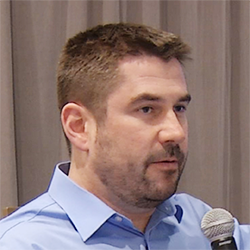Home » Dysautonomias » Cardiac Sympathetic Neuroimaging with Horacio Kaufmann, MD
Cardiac Sympathetic Neuroimaging with Horacio Kaufmann, MD
In this video Dr. Kaufmann discusses cardiac sympathetic neuroimaging as a tool that can be used to better understand the physiology and abnormal physiology of patients with autonomic disorders.
Mr. Al Ruechel: Hi everyone, I’m Al Ruechel and welcome to this segment where we’re going to be talking about cardiac sympathetic neuro imaging. Joining us right now is doctor Horatio Kaufman. Doctor Kaufman thank you for coming by.
Dr. Horacio Kaufmann: My pleasure.
Mr. Ruechel: Appreciate your time, so let’s start off right off the top with telling me a little bit about yourself and how you’re involved.
Dr. Kaufmann: Well, I’m a neurologist and I’m the director for the autonomic disorder division of the department of neurology at New York University. And I’m a professor of neurology there with an endowed chair and we also have a big center called the dysautonomia center that takes care of patients with either genetic or neurodegenerative disorders that affect the autonomic nervous system and I’ve been doing that for around forty years.
Mr. Ruechel: Now everybody wishes you could come up with a definitive cause and effect because if we did, we would know how to treat people a little better. Tell me about this cardiac sympathetic neuro imaging. Tell me exactly what that is.
Dr. Kaufmann: Ok, it’s a very interesting tool that can be used to understand some of the physiology and abnormal physiology of patients with autonomic disorders. So, let me tell you, you see a big difference between the motor system, the somatic system, and the autonomic system, is that in the somatic motor system meaning the voluntary system the neuron that goes from the central nervous system to the target organ, to the mast cell, is just one neuron, so it’s just one long cable that goes from the spinal cord to the mast cell so the signal is sent from the brain and goes directly to the mast cell. In the autonomic nervous system, there’s a big difference, the gap between the spinal cord and the effector organ is bridged by two neurons, instead of one. So, the first neuron is called the preganglionic neuron and has the cell body in the spinal cord and the cable, which is the axon, comes out and then it synapses or joins with a second neuron that’s in what is called an autonomic ganglia in the, in the case of the sympathetic ganglia they are to the side, to both sides of the spinal cord and from that ganglia a second neuron comes out which is the one that actually innervates the target organ. Now, why am I telling you this? Why is this important? Well, the reason is that in autonomic disorders, in neuro degenerative disorders, and others but that we are going to focus on that, on these. The problem may be in the first neuron or in the second neuron. So, the first neuron is called the preganglionic neuron and that is the one I mentioned comes from the spinal cord to the ganglia and the second one from the ganglia to the target organ is the post ganglionic neuron. Now, in disorders like Parkinson’s disease, specifically in Parkinson’s disease it’s quite interesting that the problem is in the second neuron. The first one, the preganglionic may also be affected, but what’s peculiar is that the second one the peripheral one, the one that goes directly to the target organ that in itself is affected. So, in a way Parkinson’s disease, although it’s a problem of the brain, is really similar to peripheral neuropathy, it affects the nerves, the cables, that are outside the brain and specifically that second neuron in the autonomic system. Now, why again is this just an interesting detail with little relevance well I believe, and a lot of people agree on that, that it’s more than just a little physiologic detail because it may help you decide or organize better treatment and why is that? You see in Parkinson’s disease as I mentioned to you that second neuron is the one that’s affected. So, using, which was your original question, what is sympathetic neuro imaging, what you can do, you can put what is called a tracer which is taken up by the neurons that tracer is radioactive with a counter outside you can see how much of that tracer was taken by the neuron. So, again you inject the tracer the tracer is taken by the neuron, by a normal mechanism it’s taken in, you look at it with a camera and you see how much of that tracer was taken in. Now, to take that tracer in, the neuron has to work. If the neuron is not working there is no tracer. So, in people with Parkinson’s you give them the tracer and see that their heart is denervated and many many of these patients a high percentage of these patients have either partial or even complete denervation, sympathetic denervation of their heart of myocardium. Now, patients that may look like Parkinson’s but have a different disease called multiple system atrophy which is a big distinction, MSA, many of those, not all, but in general that second neuron is spared, is normal, it is the neuron number one, the one that is in the spinal cord that is affected. So, cardiac sympathetic neuro imaging can allow you, is another method that can help you distinguish two diseases that are very similar, clinically. When you see the patient in the office, they may look particularly parkinsonian form of the multiple system atrophy, looks very similar to Parkinson’s disease. How you distinguish them. There are a number of ways you can distinguish them, one of them is this sympathetic neuro imaging of the heart which is painless and safe.
Mr. Ruechel: Now is that the common practice? That’s what they use then for diagnosis then?
Dr. Kaufmann: You know, unfortunately it’s not, in the US, it’s not frequently used and the reason it’s not frequently used is just an insurance problem.
Mr. Ruechel: Oh ok, expensive.
Dr. Kaufmann: Well, many tests are expensive it’s just that many insurances will not consider a differential diagnosis between Parkinson’s and multiple system atrophy a reason to pay for the test. So, the same test, and that’s the way it’s done, the same test can be used to diagnose a rare tumor called pheochromocytoma so it’s used MIBG, that’s the name of the tracer, and many times using that diagnosis the patient gets the test but otherwise it’s not done and that’s the reason the test is not popular in the US, whereas it’s quite popular in Europe and in Japan.
Mr. Ruechel: What, is anything going to have to happen to change that? Or is that likely to change now, or is there any other tool that is as accurate as this?
Dr. Kaufmann: You know, one interesting or problem in neurology is the differential diagnosis between Parkinson’s disease and multiple system atrophy. I think this test is very useful, it’s not 100% but is very useful and I hope people are going to use it more, we tried to use it, it’s not the only test there are a number of clinical features that distinguish one from the other. Also, magnetic resonance imaging of the brain may have some differences, but importantly this is not the MIBG the sympathetic neuroimaging should be, I think it should be used more.
Mr. Ruechel: So, if physicians are watching this right now what would you want them to know about the sympathetic neuroimaging?
Dr. Kaufmann: Well, I would like them to know that it is a very useful test that if they have the possibility of explaining the insurance carrier why they needed the test I think it’s very useful in the making the differential diagnosis.
Mr. Ruechel: And as far as patients, if a patient is watching this what should they know? Is this something they should be asking their doctor about?
Dr. Kaufmann: I think they should, I think they should, I think the test is available and, in many instances, it’s for their own advantage to have it. Unfortunately deciding public policy in the US is above my pay level.
Mr. Ruechel: It’s above all of our pay levels
Mr. Ruechel: Doctor thank you so much for your work and keep it going.
Dr. Kaufmann: Thank you very much.

Wolfgang Singer, MD
Associate Professor of Neurology
Mayo Clinic Rochester, MN































